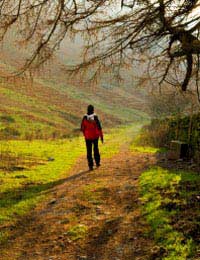Avoiding Leg Cramps When Walking

Most of the time, hiking is as injury-free a pastime as anyone is likely to undertake. There might be a slight sprain from a fall, but that’s usually the most extreme sort of problem you’re going to encounter.
That said, there is one thing that can often happen to hikers – leg cramps. They’re painful, as anyone who has experienced one knows, and can leave you hobbling for a while, even after the cramp has passed. You can take steps to try and make sure they never happen, although there are no guarantees; sooner or later you might suffer.
What Causes Leg Cramps?
There are three main causes of leg cramps. They can be due to heavy fatigue - basically pushing yourself too hard - an imbalance of electrolytes or simply dehydration. The cramps can occur either in the front or back of the thigh, or in the muscles deep in the calf.You’re more likely to suffer cramps if you’re unused to hiking and are on a long, gruelling walk. Work up to that gradually, and allow your muscles to become used to hiking. Regular exercise, saying walking for 30 minutes every other day, will strengthen your legs.
You should also make sure you have ample to drink when hiking. Walking can deplete your liquid levels and these need to be refilled. Have a full water bottle and drink from it regularly as you go. You can use sports drinks to keep up the electrolyte levels. You should also have food with you, perhaps a lunch or maybe snacks, and stop to eat when hungry.
Stopping Cramps
Making sure you’re properly hydrated and that you eat in order to prevent your blood sugar levels falling are both good ways to stop cramps attacking you. They’re not the only things you can do, however.Before you set off, warm up as you might if you were going for a jog. Perform some stretching exercises to allow the muscles to heat up. You can also rub your legs, effectively giving them a massage, and that will have the same effect. When you’re out hiking, don’t sit in one place for too long. This allows the muscles to cool again and can cause cramps.
Wear good footgear. Proper hiking boots or shoes will give ample support to the arch and leg and cut down on the incidence of cramps.
If You Have a Cramp
At some point, no matter how you try to avoid it, you’ll probably suffer a cramp when hiking. When that happens, you need to know how to make it pass. If the cramp is at the front of your right thigh, you need to sit, then put your left ankle behind the right ankle. Pull back hard with the right ankle and try to stop that with the left ankle. This action contracts the quadriceps muscles in the thigh. For the left thigh, do the same in reverse.For a cramp at the back of the right thigh, sit so that your right ankle is behind the left ankle. Try to push the right ankle forward and stop it with the left ankle. This will cause the hamstring to contract, relieving the cramp. Reverse the legs for cramp in the back of the left thigh.
With a cramp in the right calf, you need to sit and have the left foot over the instep of the right foot. Pull the right foot up towards yourself while pushing as hard as possible with the left foot. This should ease the pain. For a cramp in the left calf, simply do this as a mirror image.
- The Best Hiking Snacks
- Walking for Physical Rehabilitation
- How to Prepare for the Hiking Season
- Hiking for Older People
- Walking for Fitness: A Plan
- Fell Running: Is it for You?
- What is SwimHiking?
- Walking on Roads
- A Solo Walking Guide
- How To Avoid Blisters When Hiking
- General Health And Safety When Walking
- What to do in an Emergency
- Walking for Health
- Walking Injuries
- How to Prevent Walking Injuries
- How To Take Care Of Your Feet When Hiking
- Nutrition for Walking


Re: Walking on Roads
I have never attempted any form of hiking. This year i am 87, I’m pretty’s fit, I walk with dog between five and. Six miles every day, summer and…
Re: Starting a Walking Club
Hi I'm a naturist from North Wales and wanted to reach out to people that would like to join a clothing optional walk what's the best way…
Re: Starting a Walking Club
Do I need insurance for a walk/run group?. It’s a completely free group so no joining fee or charges. It’s run by volunteers. I don’t…
Re: Join A Walking Club
I need to hike...do something for my self...I love the outdoors and hiking...I need to meet new friends...who injoys the outdoors like…
Re: Starting a Walking Club
What sort of paperwork/ registration/ insurance might you need for walking group?
Re: Join A Walking Club
Hi, Any advice on liability/protecting yourself when setting up a walking club? What if someone hurts themselves? Thanks, Sam
Re: Starting a Walking Club
Hello, Do you know of any software that facilitates putting together walking/hiking clubs programme schedule? I am looking for…
Re: Join A Walking Club
I am looking to join a walking/hiking club in the Southampton/Hampshire area. I am 50 and have signed up for London to Brighton Challenge and…
Re: Join A Walking Club
Looking for a short walk partner n to make friends in tipton area of west midlands
Re: Join A Walking Club
Hi I am 33 and am looking to join a walking club for health and social reasons. I currently live in huntingdonshire.